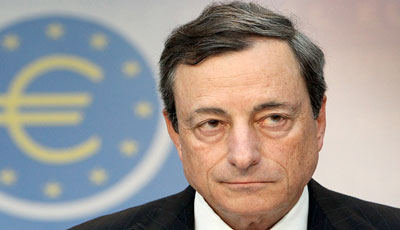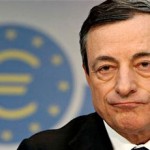Draghi’s dilemma: ECB’s five options to boost the eurozone economy

The European Central Bank president is poised to take action to tackle inflation in the single currency bloc. Here are some of his options
After October’s meeting of the European Central Bank’s governing council, the bank’s president, Mario Draghi, said it was “willing and able to act by using all the instruments available within its mandate, if warranted”. Here are some of the options it might take to fulfil that promise on Thursday:
Extending quantitative easing for longer
The ECB’s €1.1tn (£780bn) quantitative easing (QE) scheme was announced in January and involved using electronically created money to buy bonds. The ECB hoped financial institutions would invest the proceeds elsewhere in the eurozone economy and that the programme would drive down the value of the euro, making exports more competitive. The current phase of QE is due to finish in September, but Draghi has always said it would continue, “until we see a sustained adjustment in the path of inflation”. With inflation at just 0.1% in November, he could shift that deadline into 2017.
Increasing the scale of monthly bond purchases
Draghi and his colleagues could increase the value of the government bonds they buy each month, from the current €60bn a month level. However, some analysts argue there are risks that the supply of bonds is not big enough to accommodate a big expansion. Draghi could also widen the scope of the bond purchases to include riskier asset classes.
Cutting the deposit rate
The ECB already pays a negative deposit rate, of -0.2%, on reserves held at the central bank. In other words, banks must in effect pay the ECB for looking after their money: a measure aimed at keeping money flowing around the economy. The ECB could cut this rate further, which some analysts think could be as low as -0.4%.
There are also suggestions that it could introduce a two-tier deposit rate, similar to that adopted by the Danish and Swiss central banks, to penalise banks more heavily, the more of their reserves they keep out of circulation at the ECB.
Forward guidance
Draghi is renowned for using carefully honed statements to direct the markets, most memorably when he promised at the height of the eurozone crisis in July 2012 that he would do “whatever it takes” to safeguard the single currency. He could use a similar dose of verbal reassurance on Thursday to convince investors the ECB will not let the economy slide into deflation.
Nothing at all
Few analysts are betting on it, but it’s not impossible that the ECB could decide to sit on its hands. Draghi may be a man of action, but he has previously faced strong resistance within the governing council, in particular from the German Bundesbank governor, Jens Weidmann.
Source: The guardian – Draghi’s dilemma: ECB’s five options to boost the eurozone economy



























